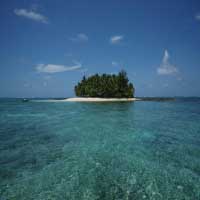from wikipeida:
The last major U.S. diversion is at Imperial Dam , where over 90 percent of the river's flow are moved into the All-American Canal to irrigate California's Imperial Valley , the most productive winter agricultural region in the United States. [ 32 ]
Below Imperial Dam only a small portion of the Colorado River makes it past Yuma, Arizona and the confluence with the intermittent Gila River – which carries runoff from western New Mexico and most of Arizona – before defining about 24 miles (39 km) of the Mexico–United States border .
At Morelos Dam , the entire remaining flow of the Colorado is diverted to irrigate the Mexicali Valley , among Mexico's most fertile agricultural lands . [ 33 ] Below San Luis Río Colorado , the Colorado passes entirely into Mexico, defining the Baja California – Sonora border; in most years, the stretch of the Colorado between here and the Gulf of California is dry or a trickle formed by irrigation return flows. The Hardy River provides most of the flow into the Colorado River Delta , a vast alluvial floodplain covering about 3,000 square miles (7,800 km 2 ) of northwestern Mexico. [ 34 ] A large estuary is formed here before the Colorado empties into the Gulf about 75 miles (121 km) south of Yuma. Before 20th-century development dewatered the lower Colorado, a major tidal bore was present in the delta and estuary; the first historical record was made by the Croatian missionary in Spanish service Father Ferdinand Konš?ak on July 18, 1746. [ 35 ] During spring tide conditions, the tidal bore – locally called El Burro – formed in the estuary about Montague Island in Baja California and propagated upstream. [ 36 ]

